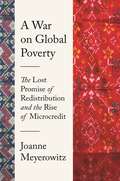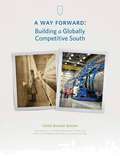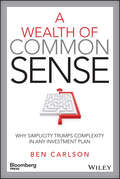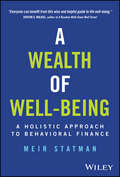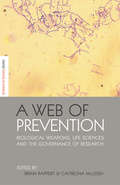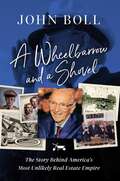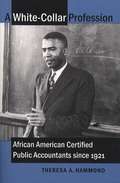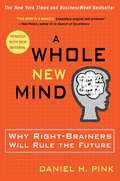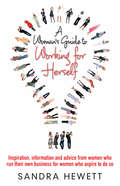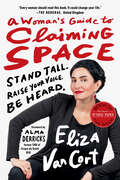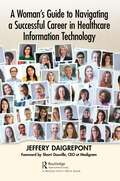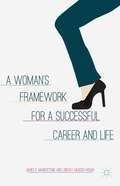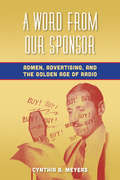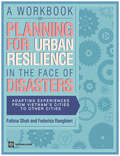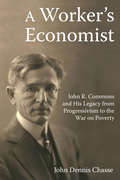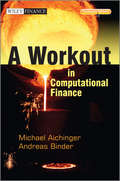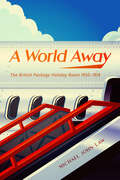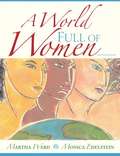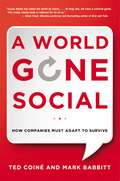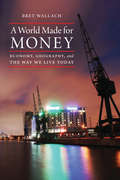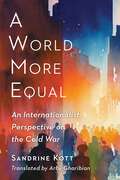- Table View
- List View
A War on Global Poverty: The Lost Promise of Redistribution and the Rise of Microcredit
by Joanne MeyerowitzA history of US involvement in late twentieth-century campaigns against global poverty and how they came to focus on women A War on Global Poverty provides a fresh account of US involvement in campaigns to end global poverty in the 1970s and 1980s. From the decline of modernization programs to the rise of microcredit, Joanne Meyerowitz looks beyond familiar histories of development and explains why antipoverty programs increasingly focused on women as the deserving poor.When the United States joined the war on global poverty, economists, policymakers, and activists asked how to change a world in which millions lived in need. Moved to the left by socialists, social democrats, and religious humanists, they rejected the notion that economic growth would trickle down to the poor, and they proposed programs to redress inequities between and within nations. In an emerging “women in development” movement, they positioned women as economic actors who could help lift families and nations out of destitution. In the more conservative 1980s, the war on global poverty turned decisively toward market-based projects in the private sector. Development experts and antipoverty advocates recast women as entrepreneurs and imagined microcredit—with its tiny loans—as a grassroots solution. Meyerowitz shows that at the very moment when the overextension of credit left poorer nations bankrupt, loans to impoverished women came to replace more ambitious proposals that aimed at redistribution.Based on a wealth of sources, A War on Global Poverty looks at a critical transformation in antipoverty efforts in the late twentieth century and points to its legacies today.
A Warrant to Kill: A True Story of Obsession, Lies, and a Killer Cop
by Kathryn CaseyThis book tells about the death of Susan White by police officer Kent McOwan, and the trial that followed.
A Way Forward
by Peter A. Coclanis Daniel P. GittermanIn the last half century, North Carolina and the South have experienced rapid economic growth. Much of the best analysis of this progress came from two North Carolina-based research organizations: the Southern Growth Policies Board and MDC (originally a project of the North Carolina Fund). Their 1986 reports are two of the best assessments of the achievements and limitations of the so-called Sunbelt boom. On November 17, 2011, the Global Research Institute at the University of North Carolina at Chapel Hill and the Institute for Emerging Issues at North Carolina State University co-hosted a public discussion to build on these classic reports and to offer fresh analyses of the current challenges facing the region. A Way Forward, which issued from this effort, features more than thirty original essays containing recommendations and strategies for building and sustaining a globally competitive South.
A Wealth of Common Sense
by Ben CarlsonA simple guide to a smarter strategy for the individual investor A Wealth of Common Sense sheds a refreshing light on investing, and shows you how a simplicity-based framework can lead to better investment decisions. The financial market is a complex system, but that doesn't mean it requires a complex strategy; in fact, this false premise is the driving force behind many investors' market "mistakes. " Information is important, but understanding and perspective are the keys to better decision-making. This book describes the proper way to view the markets and your portfolio, and show you the simple strategies that make investing more profitable, less confusing, and less time-consuming. Without the burden of short-term performance benchmarks, individual investors have the advantage of focusing on the long view, and the freedom to construct the kind of portfolio that will serve their investment goals best. This book proves how complex strategies essentially waste these advantages, and provides an alternative game plan for those ready to simplify. Complexity is often used as a mechanism for talking investors into unnecessary purchases, when all most need is a deeper understanding of conventional options. This book explains which issues you actually should pay attention to, and which ones are simply used for an illusion of intelligence and control. Keep up with-or beat-professional money managers Exploit stock market volatility to your utmost advantage Learn where advisors and consultants fit into smart strategy Build a portfolio that makes sense for your particular situation You don't have to outsmart the market if you can simply outperform it. Cut through the confusion and noise and focus on what actually matters. A Wealth of Common Sense clears the air, and gives you the insight you need to become a smarter, more successful investor.
A Wealth of Experience: Using the Past, Inventing the Future--Cultivating Your Integrative Thinking Skills
by Roger L. Martin Sunil GuptaYour experiences form your most practical and tangible knowledge. This chapter illustrates how experiences that deepen mastery and nurture originality are the most powerful in enhancing integrative thinking capacity.
A Wealth of Well-Being: A Holistic Approach to Behavioral Finance
by Meir StatmanUnravel the complex relationship between finances and life well-being In A Wealth of Well-Being: A Holistic Approach to Behavioral Finance, Professor Meir Statman, established thought leader in behavioral finance, explores how life well-being, the overarching aim of individuals in the third generation of behavioral finance, is underpinned by financial well-being, and how life well-being extends beyond financial well-being to family, friendship, religion, health, work, and education. Combining recent scientific findings by scholars in finance, economics, law, medicine, psychology, and sociology with real-life stories at the intersection of finances and life, this book allows readers to clearly see how finances are intertwined with life well-being. In this book, readers will learn: How dating, marriage, widowhood, and divorce are all affected by finances and affect them Why the relationship between parents, grandparents, children, and friends changes as finances fluctuate How finances affect choices of education, such as colleges, and how these choices vary across different cultures around the world A Wealth of Well-Being: A Holistic Approach to Behavioral Finance earns a well-deserved spot in the libraries of financial advisors, financial planners, investors, and all individuals looking to move beyond standard finance and enhance both financial well-being and life well-being.
A Web of Prevention: Biological Weapons, Life Sciences and the Governance of Research (The Earthscan Science in Society Series)
by Brain Rappert Caitríona McLeishWeb of Prevention provides a timely contribution to the current debate about life science research and its implications for security. It is an informative guide for both experts and the public. It is a forward-looking contribution covering both ends of the equation and creates momentum for the current discussion on effective preventive measures and effective control measures. While there are no guarantees for preventing misuse, there are nonetheless crucial steps the world community can take towards the overarching goal of a global network for the life sciences. This book sheds light on concrete steps toward the achievement of this worthy goal. "This book with its collection of essays provides an in-depth analysis of the various mutually reinforcing elements that together create and strengthen a web of prevention - or of assurance - that is vital to ensure that the advances in the life sciences are not misused to cause harm. All those engaged in the life sciences and in policy making in governments around the world should read this book so they can take steps to strengthen the web preventing biological weapons". From the Foreword by Dr Gabriele Kraatz-Wadsack, Chief, Weapons of Mass Destruction Branch, Office for Disarmament Affairs, United Nations. "Since September 11, 2001 in many countries renewed attention has been given to how research in the life sciences might inadvertently or intentionally facilitate the development of biological or chemical weapons. This state-of-the-art volume examines the full extent of the issues and debates. Coverage includes an overview of recent scientific achievements in virology, microbiology, immunology and genetic engineering with a view to asking how they might facilitate the production of weapons of mass destruction by state, sub-state or terrorist organizations. Consideration is given to what we have and haven't learned from the past. Employing both academic analysis and reflections by practitioners, the book examines the security-inspired governance regimes for the life sciences that are under development. Ultimately the authors examine what is required to form a comprehensive and workable web of prevention and highlight the importance of encouraging discussions between scientists, policy makers and others regarding the governance of vital but potentially dangerous research".Dr Graham S. Pearson, Visiting Professor of International Security, University of Bradford, UK and previously Director-General, Chemical and Biological Defence Establishment, UK
A Wheelbarrow and a Shovel: The Story Behind America's Most Unlikely Real Estate Empire
by John BollA Wheelbarrow and a Shovel documents the rags-to-riches success story of John Boll who built a real estate empire by developing manufactured home communities around the world then selling his company to the State of Washington Pension Fund for $2.3 billion.A Wheelbarrow and a Shovel documents the truly remarkable story of one of America&’s most unlikely business success stories. Starting with only a wheelbarrow and a shovel, as well as the same American dream that led his parents to leave their native Holland for the United States, John Boll built a real estate empire in the most unlikely of ways—by developing and improving manufactured home communities around the country. It&’s a rags-to-riches tale that could only happen in America—and only with the hand of God leading the way. Before Boll sold his company to the State of Washington Pension Fund for $2.3 billion, he was the first person to take a collection of mobile home communities to Wall Street.
A White-Collar Profession
by Theresa A. HammondAmong the major professions, certified public accountancy has the most severe underrepresentation of African Americans: less than 1 percent of CPAs are black. Theresa Hammond explores the history behind this statistic and chronicles the courage and determination of African Americans who sought to enter the field. In the process, she expands our understanding of the links between race, education, and economics. Drawing on interviews with pioneering black CPAs, among other sources, Hammond sets the stories of black CPAs against the backdrop of the rise of accountancy as a profession, the particular challenges that African Americans trying to enter the field faced, and the strategies that enabled some blacks to become CPAs. Prior to the 1960s, few white-owned accounting firms employed African Americans. Only through nationwide networks established by the first black CPAs did more African Americans gain the requisite professional experience. The civil rights era saw some progress in integrating the field, and black colleges responded by expanding their programs in business and accounting. In the 1980s, however, the backlash against affirmative action heralded the decline of African American participation in accountancy and paved the way for the astonishing lack of diversity that characterizes the field today.
A Whole New Mind
by Daniel H. PinkThe future belongs to a different kind of person with a different kind of mind: artists, inventors, storytellers-creative and holistic "right-brain" thinkers whose abilities mark the fault line between who gets ahead and who doesn't.Drawing on research from around the world, Pink (author of To Sell Is Human: The Surprising Truth About Motivating Others) outlines the six fundamentally human abilities that are absolute essentials for professional success and personal fulfillment--and reveals how to master them. A Whole New Mind takes readers to a daring new place, and a provocative and necessary new way of thinking about a future that's already here.
A Woman's Guide To Working For Herself: Inspiration, Information And Advice From Women Who Run Their Own Business, For Women Who Aspire To Do So
by Sandra HewettThe rise of the female entrepreneur over the past 30 years is a cause for celebration in the UK. Whether driven by unfair treatment at work, conflict between office and family life, or the inspiration of a great business idea, hundreds of thousands of women are motivated to work for themselves. There are many benefits to being self employed but many, too, are the challenges. Women need confidence, support, and often some start-up finance to make a go of it. This book will provide inspiration, information and loads of advice from a range of women who run their own business. It starts by recognising that women start all kinds of ventures in many different circumstances: - Developing an idea from home - Freelancing - Joining the 'mumpreneurs' - Launching a business with capital investment - Buying a franchise or creating a franchise - Becoming an direct selling agent - Creating a social enterprise - Starting up after redundancy or unemployment - Breaking new ground - young, retired, disabled, disadvantaged
A Woman's Guide To Working For Herself: Inspiration, Information and Advice from Women Who Run Their Own Business, for Women Who Aspire to Do So
by Sandra HewettThe rise of the female entrepreneur over the past 30 years is a cause for celebration in the UK. Whether driven by unfair treatment at work, conflict between office and family life, or the inspiration of a great business idea, hundreds of thousands of women are motivated to work for themselves. There are many benefits to being self employed but many, too, are the challenges. Women need confidence, support, and often some start-up finance to make a go of it. This book will provide inspiration, information and loads of advice from a range of women who run their own business. It starts by recognising that women start all kinds of ventures in many different circumstances: - Developing an idea from home - Freelancing - Joining the 'mumpreneurs' - Launching a business with capital investment - Buying a franchise or creating a franchise - Becoming an direct selling agent - Creating a social enterprise - Starting up after redundancy or unemployment - Breaking new ground - young, retired, disabled, disadvantaged
A Woman's Guide to Claiming Space: Stand Tall. Raise Your Voice. Be Heard.
by Eliza VanCortFor too long, women have been told to confine themselves—physically, socially, and emotionally. Eliza VanCort says now is the time for women to stand tall, raise their voices, and claim their space.Women fight the pressure to make themselves small in private, professional, and public spaces. Eliza VanCort, a teacher, consultant, and speaker, provides the necessary tools for women to rewrite the rules and create the stories of their choosing safely and without apology. VanCort identifies the five key behaviors of all “Space Claiming Queens”: use your voice and posture to project confidence and power, end self-sabotage, forge connections, neutralize unsafe spaces, and unite across differences. Through personal narrative, research, and actionable strategies, VanCort provides how-tos on combating challenges like antimentors and microaggressions and gives advice for building up your “old girls” club, asking for what you're worth, and owning your space without apology.Bold, fun, and enlightening, this book is birthed from VanCort's incredible story. Having a mother with schizophrenia forced VanCort to learn to be small and invisible at an early age, and suffering a traumatic brain injury as an adult required her to rethink communication from the ground up. Drawing on these experiences, and those of real women everywhere, VanCort empowers women to claim space for themselves and for their sisters with courage, empathy, and conviction because “when we rise together, we rise so much higher.”
A Woman's Guide to Navigating a Successful Career in Healthcare Information Technology
by Jeffery DaigrepontThis book features over 50 of the industry’s brightest female pioneers who share insightful lessons backed by several years of experience, as well as tips for navigating a successful career in HIT. The intent of this book is to provide the opportunity to capture stories from highly successful women to inspire the next generation who want to pursue a career in HIT and to inspire those already working in the field who are eager to advance in their careers. This book also provides insights on industry opportunities, ways to deal with harassment, the history of female tech innovators, and negotiating competitive salary and employment agreements. Additional industry experts provided guidance on tapping into venture capital funding and tools for career development. A comprehensive resource guide and glossary of industry terms are also included. Co-authors included: Amy Sabillon, MSI, Ayanna Chambliss, CAP, SHRM-CP, Lindsay Rowlands, MHA, and Stacey B. Lee, JD.
A Woman’s Framework for a Successful Career and Life
by James Hamerstone Lindsay Musser HoughSuccessfully Navigating a Profession is a comprehensive resource for young women trying to figure out how to build a successful career in today's world. Unfortunately, young women navigating the current workforce are faced with career metaphors that can make achieving a successful career tantamount to sending a text message from a rotary phone. While building a satisfying career in today's economy isn't quite as easy as laying on your couch and texting in your American Idol votes, it doesn't have to seem impossible either. This book explains how. Its 2010 women routinely serve on the President's cabinet (President Obama's has five), lead large corporations such as Pepsi and Xerox, and comprise 60 percent of college graduates. The ingredients to the 'secret sauce' of a woman's career aren't so secret anymore. However, few books provide those ingredients in a straightforward, organized way. In this timely work, the authors lay out, one by one, the building blocks for a successful, lifelong career focusing on skills (such as leadership and communication), mentoring, work-life fit, and personal branding. Is this book a cookbook for success of a modern women's career? Probably not; even the most accomplished women don't claim to have followed a formulaic path to success. What Hamerstone and Musser Hough do is help a young woman think about what her satisfying career might really look like and provide a unifying framework for how to get there. Appropriate for a young woman just entering the workforce up through a woman in mid-career (who doesn't have time to read a dozen different books on various narrow career topics), Successfully Navigating a Profession lays out the key elements of a successful career in a concise and logical manner. Those elements include core skills - Leadership, Communication, Negotiation as well as Networking, Mentoring, Career Path Navigation, Work-Life Fit, and Personal Brand. Each topic includes a summary of key research and leading thought on these issues and is infused with examples and commentary from successful women gathered through interviews the authors conducted with women of all ages in corporate, government, and non-for-profit organizations. Most importantly, each chapter answers the 'So What Does this Mean for Me?' question by offering realistic, concrete suggestions for how women can Successfully Navigate a Profession. The authors offer a unique blend of practical and academic experiences that provides the reader with a framework to successfully navigate her career in today's economy.
A Word from Our Sponsor: Admen, Advertising, and the Golden Age of Radio
by Cynthia B. MeyersDuring the “golden age” of radio, from roughly the late 1920s until the late 1940s, advertising agencies were arguably the most important sources of radio entertainment. Most nationally broadcast programs on network radio were created, produced, written, and/or managed by advertising agencies: for example, J. Walter Thompson produced “Kraft Music Hall” for Kraft; Benton & Bowles oversaw “Show Boat” for Maxwell House Coffee; and Young & Rubicam managed “Town Hall Tonight” with comedian Fred Allen for Bristol-Myers. Yet this fact has disappeared from popular memory and receives little attention from media scholars and historians. By repositioning the advertising industry as a central agent in the development of broadcasting, author Cynthia B. Meyers challenges conventional views about the role of advertising in culture, the integration of media industries, and the role of commercialism in broadcasting history.Based largely on archival materials, A Word from Our Sponsor mines agency records from the J. Walter Thompson papers at Duke University, which include staff meeting transcriptions, memos, and account histories; agency records of BBDO, Benton & Bowles, Young & Rubicam, and N. W. Ayer; contemporaneous trade publications; and the voluminous correspondence between NBC and agency executives in the NBC Records at the Wisconsin Historical Society. Mediating between audiences’ desire for entertainment and advertisers’ desire for sales, admen combined “showmanship” with “salesmanship” to produce a uniquely American form of commercial culture. In recounting the history of this form, Meyers enriches and corrects our understanding not only of broadcasting history but also of advertising history, business history, and American cultural history from the 1920s to the 1940s.
A Workbook on Planning for Urban Resilience in the Face of Disasters
by Federica Ranghieri Fatima ShahThis Workbook offers a step-by-step guide for city officials in proactively planning for natural disasters and climate change impacts. It is based on learning from three cities in Vietnam - Ha Noi, Can Tho, and Dong Hoi - that developed Local Resilience Action Plans (LRAPs) containing a set of prioritized actions, related to both infrastructure as well as policy/ regulatory and socioeconomic actions. These LRAPs are based on vulnerability and risks assessments, a gaps analysis drawing on an inventory of planned investments and policy changes, and multi-stakeholder priority setting. The on-the-ground learning from these pilot cities in Vietnam has paved the way for cities in China, Indonesia, and the Philippines to embark on similar processes. This Workbook is a complement to the best-selling Climate Resilient Cities: A Primer on Reducing Vulnerabilities to Disasters (2009).
A Worker's Economist: John R. Commons and His Legacy from Progressivism to the War on Poverty
by John Dennis ChasseJohn R. Commons is one of the few reformers of the past century whose major works are still actively read, whose ideas are still debated, and whose principles are still applied to the analysis of contemporary problems. His life spanned the years of America’s “Great Transformation,” from a nation of shopkeepers, farmers, and small towns to one of giant corporations, landless laborers, and crowded cities. He became involved in almost every aspect of America’s response to the damaging side effects of that transformation. A Worker’s Economist begins with John Commons’ childhood and education and continues through his life as a scholar, teacher, administrator, and reformer. Commons’ list of accomplishments are great in number and overall effect. He worked on the staff of the first government commission to investigate the economic and social consequences of corporate mergers. He served as a public representative on the commission that investigated industrial violence and workplace relations. He was a participant observer in America’s largest and most historic mineworkers’ strike. He wrote and administered the nation’s first constitutional worker compensation law. He developed principles of social reform and public administration that his students carried into the design and administration of the Social Security system as well as Lyndon B. Johnson’s War on Poverty. John Dennis Chasse reviews Commons’ major works, describes the people with whom he worked, and follows the fortunes of the unions that were intrinsic to his vision of “collective democracy.” As a final testament to Commons’ importance, Chasse considers his legacy as it endures in the work of his students and beyond.
A Working Lunch: Real World Strategies for Assessing Potential Synergies, Evaluating Make v. Buy Decisions, and Communicating Effectively with Team Members
by Jay Barney Patricia Gorman Clifford"What I Didn't Learn in Business School" invites readers to follow new consultant Justin Campbell as he joins an elite team hired by a chemical firm to assess the potential of a newly developed technology. Join Justin in this chapter as he meets with the vice president in charge of running the firm's struggling package factory and listen in as Justin's team discusses strategies for testing synergies and weighs the intricacies of outsourcing the manufacturing of the new technology vs. the client bringing the work in-house. Authors Jay Barney and Trish Gorman Clifford bring these strategy lessons to life, inviting you to learn first-hand from Justin's mistakes as he works with his team to evaluate different approaches. This chapter was originally published as Chapter 4 of "What I Didn't Learn in Business School: How Strategy Works in the Real World."
A Workout in Computational Finance
by Andreas Binder Michael AichingerA comprehensive introduction to various numerical methods used in computational finance todayQuantitative skills are a prerequisite for anyone working in finance or beginning a career in the field, as well as risk managers. A thorough grounding in numerical methods is necessary, as is the ability to assess their quality, advantages, and limitations. This book offers a thorough introduction to each method, revealing the numerical traps that practitioners frequently fall into. Each method is referenced with practical, real-world examples in the areas of valuation, risk analysis, and calibration of specific financial instruments and models. It features a strong emphasis on robust schemes for the numerical treatment of problems within computational finance. Methods covered include PDE/PIDE using finite differences or finite elements, fast and stable solvers for sparse grid systems, stabilization and regularization techniques for inverse problems resulting from the calibration of financial models to market data, Monte Carlo and Quasi Monte Carlo techniques for simulating high dimensional systems, and local and global optimization tools to solve the minimization problem.
A World Away: The British Package Holiday Boom, 1950–1974
by Michael John LawThe 1950s and 1960s were a transformative period in Britain, and an important part of this was how Britons’ lives were changed when they began flying abroad for their holidays. In A World Away Michael John Law investigates how something that previously only the rich could afford became available to working-class holidaymakers.A World Away moves beyond the big players in the tourist industry and technical accounts of the airplanes used by tour operators to tell the histories of the people who were there, both tourists and tour guides, using their personal testimonies. Until now there has been uncertainty about the identity of these new tourists: some feared they were working-class intruders who might invade the pristine destinations favoured by the elite; others claimed that most were from the middle class. Using new data derived from flight accident investigations, Law explains the complex origins of these new flyers. In British society this unprecedented mobility could not go unpunished, and the new tourists were lampooned in books and newspapers aimed at the middle classes. Law shows how popular culture, movies, and music influenced the decision to travel, and what actually happened when these new holidaymakers went abroad.Law investigates the package tour industry from its mid-century origins through its inherent weaknesses, governmental interference, and unforeseen world events that contributed to its partial failure in the early 1970s. A World Away provides the definitive account of this important change in postwar British society.
A World Full of Women (5th edition)
by Martha Ward Monica EdelsteinWelcome to a world full of women. This book has two goals: to explore and validate woman-centered experiences, and to illuminate the common grounds of being female on Planet Earth.
A World Gone Social: How Companies Must Adapt to Survive
by Ted Coiné Mark BabbittThe Social Revolution's impact on the business world cannot be over-estimated. Like the meteor that likely precipitated the end of the dinosaurs, Social is the catalyst in an extinction event--and business as we know it has changed forever. A World Gone Social offers an eye-opening look at fundamental and powerful changes the social collaboration era has set in motion: Customers now have the power--just watch what happens as more realize it! With increased transparency, businesses must be more ethical--no more pretending Command-and-control leadership is now so inefficient, it is a liability Nimble and small is the new competitive advantage--few corporations are capable of the agility required by evolving marketplaces Recruiting is now a two-way proposition, with job seekers able to peer behind the corporate curtain Relationship and community-building is how customers and brand ambassadors are won--and retained Engagement--with partners, employees, and customers--is not a luxury; it is a requirement. Each chapter provides compelling stories and concrete examples of companies demonstrating enlightened business practices and doing Social right--and some that are not--and the lessons to be learned from their experiences. Finally, readers will discover how to objectively assess the fit ness of their own company's culture and social presence. . . so they may successfully transition from a 20th- to a 21st-century "social" organization.
A World Made for Money: Economy, Geography, and the Way We Live Today
by Bret WallachA spirited and incisive survey of economic geography, A World Made for Money begins with the author stopped at a red light in Norman, Oklahoma. Observing the landscape of drugstores and banks, and for that matter the stoplight and roads themselves, Bret Wallach observes, “Everything I see has been built to make money” or, at the very least, to facilitate making money. This, he argues, is a global phenomenon that nonetheless has occurred only within the past hundred years or so. Although guidebooks and culture brokers often disparage these landscapes of commerce, Wallach—recipient of a MacArthur “genius grant”—argues that we would do well to pay them close attention.A World Made for Money provides a compelling, condensed tour of our world. From Silicon Valley to Sri Lanka, from post-Soviet Russia to post-apartheid South Africa, Wallach looks at how human beings are buying, manufacturing, working, growing and shipping food, and accessing the natural resources to fuel it all. These essential facets of daily life, propelled by the profit motive, represent a transnational force shaping our surroundings and environment in ways that may not always be beautiful (or even healthy) but that are fundamental to understanding how the world works in the twenty-first century. Wallach examines the relationship between acquisitiveness and landscape, reveals surprising contradictions and nuances, and provides fresh perspective on politically charged topics such as sprawl, deindustrialization, and agribusiness.
A World More Equal: An Internationalist Perspective on the Cold War (Columbia Studies in International and Global History)
by Sandrine KottThe post–World War II period is typically seen as a time of stark division, an epochal global conflict between the United States and the Soviet Union. But beneath the surface, the postwar era witnessed a striking degree of international cooperation. The United Nations and its agencies, as well as regional organizations, international nongovernmental organizations, and private foundations brought together actors from conflicting worlds, fostering international collaboration across the geopolitical and ideological divisions of the Cold War.Diving into the archives of these organizations and associations, Sandrine Kott provides a new account of the Cold War that foregrounds the rise of internationalism as both an ideology and a practice. She examines cooperation across boundaries in international spaces, emphasizing the role of midsized powers, including Eastern European and neutral countries. Kott highlights how the need to address global inequities became a central concern, as officials and experts argued that economic inequality imperiled the creation of a lasting peace. International organizations gave newly decolonized and “Third World” countries a platform to challenge the global distribution of power and wealth, and they encouraged transnational cooperation in causes such as human rights and women’s rights. Assessing the failure to achieve a new international economic order in the 1970s, Kott adds new perspective on the rise of neoliberalism. A truly global study of the Cold War through the lens of international organizations, A World More Equal also shows why the internationalism of this era offers resources for addressing social and global inequalities today.
